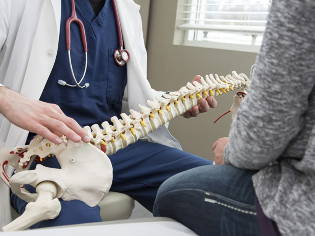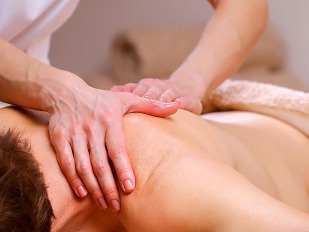With osteochondrosis of the lumbar spine, the symptoms and treatment of the disease are further discussed, the person's mobility is limited and the ability to lead a normal life is limited. Almost half of the patients have complaints of pain in this part of the back. Poll Options Are found that lumbar osteochondrosis is second only to respiratory disease.
Until recently, age-related degenerative processes were considered a major cause of pathology, and many more factors have been elucidated today. Before starting therapy, you need to understand what lumbar spine osteochondrosis is.
The disease is an abnormal change in the intervertebral discs, accompanied by dystrophy of the ligaments, the destruction of the vertebral bodies themselves. The lumbar spine suffers the most as it experiences a huge load when lifting weights in a sitting position.
Signs of lumbar spine osteochondrosis are increasingly occurring in young people as young as 30 years old. It is impossible to start the disease because the complications are associated with disability, paralysis of the lower extremities.
Main symptoms of lumbar osteochondrosis
Lumbar osteochondrosis is a deforming pathology that is in most cases a natural aging process. But high physical activity in the spine, metabolic disorders, abuse of harmful products, and alcohol accelerate this process.
The first signs of pathology do not appear immediately, so therapy does not always start on time. With osteochondrosis of the lumbar spine, the symptoms are as follows:
- the pain is more frequent in the first stage and acute in the 2-3 stages of the development of the disease (any sudden movement intensifies the discomfort and disappears during bed rest);
- In osteochondrosis, a feeling of weakness appears in the legs (tendon reflexes are lost in the lower extremities, which is clearly visible on neurological examinations); lumbar
- curvature;
- Violation of urination and defecation (depending on whether the spinal cord has been pinched).

Other symptoms of lumbar osteochondrosis can be identified: feeling of numbness in the lower back, dryness and peeling of the skin, change in color (turning blue). Sweating increases in the buttocks area. One sign of osteochondrosis of the lumbar spine is considered to be erectile dysfunction.
The severity of symptoms in lumbar spine osteochondrosis varies. Some manifestations can be combined into syndromes.
| Syndromes | Feature |
| ischemic | Here are signs of lumbar osteochondrosis due to vascular damage. The arteries begin to spasm (the process becomes constant over time). This condition is characterized by pain in the muscles of the lower leg and thigh while walking. If the blood vessels are constricted and convulsed for a long time, the nutrition of the pelvic organs as well as their functionality is disturbed. In women, pathology causes problems in the menstrual cycle, the ability to conceive a child, urination |
| Vertebra | Characterized by pain of varying intensity and localization. It is formed after the loading of the lumbar spine: tilting and lifting heavy objects. If a disc herniation occurs, the person may lose sensitivity of the legs. In this case, changes occur in the spine: posture changes, people relax, walking becomes problematic |
| Radicular | Vertebrae become unstable, compressing not only nerve roots but also blood vessels. The symptom of the syndrome is pain at the site of pinching the ends. Unpleasant feelings spread to the buttocks and legs. A person’s muscle tone increases, he is forced to change his gait. In the absence of treatment for osteochondrosis, the nerve roots become inflamed. This condition is accompanied by edema of the body tissues surrounding the spine. The blood begins to stagnate, the process of intoxication begins. With radical syndrome, pain is observed in other joints. In addition to these symptoms, a feeling of “goose dosing” appears in the lower back (lower back). In particularly difficult cases, patients can no longer move independently |
Patients with osteochondrosis of the lumbar spine should undergo a full examination to determine how severe the disease is and to determine the therapeutic regimen.

Degree of lumbar osteochondrosis
Lumbar osteochondrosis develops gradually. There are stages in the progression of the pathology such as:
- First. In this case, the nucleus pulposus inside the disc begins to move and change. Cracks appear on the fibrous ring. The nerve roots become irritated, which is indicated by back pain. At this stage of osteochondrosis, the discomfort is still local in nature, meaning that the symptoms are felt only in the area of the damaged disc. Sometimes it is a lumbago, but in the first stage of development there is often constant dull pain. The discomfort in osteochondrosis increases after the load on the lumbar spine.
- Second. This is where the destruction of the fibrous ring occurs. The mobility of the injured vertebrae increases while the muscle tissue is tensed. The distance between them decreases, they can move relative to each other. One finds it more difficult to move as one gets tired quickly, feeling severe discomfort in the lumbar region. The pain spreads to the thighs, legs, buttocks. He sweats more.
- Third. At this stage of the disease, the pain often intensifies because the fibrous ring ruptures. In this case, the nucleus pulposus leaves its place and a hernia develops. The patient feels acute pain and lumbago when the tissues and nerve roots are compressed. The discomfort becomes permanent and unbearable. The work of the internal organs was interrupted.
- Fourth. Deformation of the spine occurs. One finds it very difficult to move, but the symptom of pain is less pronounced. This does not mean at all that the pathology no longer develops. This condition indicates that a person is about to be in a wheelchair. In addition, osteophytes grow in the area of the damaged disc, which further aggravates the condition, causing the muscles to atrophy.
If the development of the disease is not controlled and therapy is not started in time, the vertebrae simply collapse and recover without a risky and difficult operation.
What to do if your disease gets worse
Lumbar osteochondrosis is a serious disease that is better not brought to the last stage. It becomes chronic quickly, as even the most effective treatment can only stop or slow down the development of the pathology.
If there is severe pain in the back area and a person is unable to move normally, this indicates an exacerbation of the pathological process. It most commonly occurs in patients who do not follow doctors ’recommendations. If an exacerbation has occurred, a person must follow these rules:
- It is better to leave physical activity completely until normal functioning of the body is restored. It is better to lie in a comfortable position that does not cause discomfort. It is good for the patient to use a hard mattress as the body in this case (especially the lumbar region) will not sag.
- A person can use a semi-rigid corset to minimize the back load. It will limit sudden movements.
- In osteochondrosis, you should slowly bend your leg at the knee on the affected side to reduce the severity of the pain. This helps relieve muscle tension and relieves pinched nerve tissue.
- In difficult cases, the applicator should be used, but should be used with caution. The procedure is performed twice a day for 30 minutes.
- You should use an anti-inflammatory ointment after a massage that gradually restores normal blood circulation and muscle tone.

Heat the affected area on the first day after the exacerbation occurs. Dry heat is applied only on the second day when the peak of pain is gone. Otherwise, tissue edema is exacerbated and the condition of the patient with osteochondrosis worsens.
Disease Diagnostics
Lumbar osteochondrosis requires a serious approach and complex therapy. It becomes easier for the patient to take the right medications, to perform the exercises prescribed by the doctor. The patient should be examined to select a therapeutic regimen. The following diagnostic methods stand out:
- X-ray. If the lumbar joints are affected, radiographic evaluation is paramount. The image is taken in several projections. It shows the damage to the discs and the condition of the spinal canal. Each projection must be perpendicular to the previous one.
- MRI or CT. The presented methods help to more accurately identify the factors that triggered the development of osteochondrosis, the condition of not only the vertebrae, but also the soft tissues, blood vessels, and nerve endings. However, the person does not feel any discomfort.
- External examination by palpation of the injured area and neurological examinations.
Only a thorough diagnosis determines whether a person actually develops osteochondrosis.
Treatment of lumbar osteochondrosis
If therapy for lumbar osteochondrosis is not performed, the patient will develop complications such as protrusion, spondyloarthrosis, hernia, inflammation of the sciatic nerve, narrowing of the spinal canal, and pelvic organ dysfunction. The person also starts limping, has paresis and paralysis.
Treating osteochondrosis of the lumbar spine involves several tasks. The inflammation that causes pain in this disease must first be eliminated. Of course, you need to stop the unpleasant symptoms themselves, as well as strengthen the muscle ligament in the lumbar region, lower extremities.
Therapy should relieve swelling and soft spasm. The patient is prescribed tools and procedures designed to improve organ function, regulate blood circulation, restore metabolic processes in the body, and expand the range of motion. Because patients have long-term treatment for osteochondrosis of the lumbar regions, they must choose methods that have a good effect and cause minimal damage. Medication, alternative treatment, physiotherapy, LF, and other methods are used.
Surgery
In advanced cases, when the disease has reached its final stage, lumbar osteochondrosis requires surgery. The help of a surgeon is needed in the presence of complications that impair the function of the organs, the hernia of the vertebrae. An emergency operation is performed if there is a risk of developing paralysis of the lower extremities.
The most effective procedure is to remove the damaged disk. A microsurgical method of treating osteochondrosis of the lumbar spine with an endoscope is also common. This procedure is less traumatic for the patient and allows him to recover in the shortest time possible.
Physiotherapy procedures
In lumbar osteochondrosis, the symptoms (treated differently) can be eliminated by physiotherapy procedures. Useful for:
- diadynamic currents;
- electrophoresis and phonophoresis;
- magnetic therapy;
- laser treatment.
Physiotherapy procedures bring maximum benefits in combination therapy in combination with drugs.
Physiotherapy exercises
Treating lumbar osteochondrosis will not be effective without performing the complex exercise prescribed by your doctor. The goal of all exercises is to improve lower back mobility, strengthen the lumbar spine, and increase spinal stability. The complex should be performed regularly.
Your doctor will usually prescribe the following exercises: bending in different directions, in a standing position, walking back and forth on all fours, tensioning your abdominal muscles in a lying position.

Massage
Can only be performed during exacerbation or remission. Thanks to the procedure, you can not only relax the spasmodic muscles, but also strengthen them. Massage is more effective after the bath. It should be done by a professional, using the right techniques: stroking, rubbing. The procedure should not be performed if there are open wounds on the back, if the person has been diagnosed with dermatological diseases or circulatory problems.
Manual therapy
manual therapy solves the same tasks as massage, but uses slightly different techniques. You can’t trust the backbone of an amateur. The procedure requires an experienced professional who will not harm you.
Medication
Medications are not essential in the treatment of lumbar spine osteochondrosis. In their selection, the general condition of the body and the stage of development of the disease matter. The following are the most effective groups of drugs to fight osteochondrosis:
Analgesics.
- NSAIDs - These drugs eliminate inflammation and the pain that accompanies it. They relieve swelling, normalize body temperature.
- Muscle relaxants - These medications are prescribed by a doctor and are only used if NSAIDs fail. Muscle relaxers help relieve muscle cramps.
- Chondroprotectors - keep cartilage in good condition without breaking it down. But they are only effective if this layer is not completely erased.
- Steroidal anti-inflammatory drugs. In the most advanced cases, they are selected last.
- Multivitamins and B Vitamins - The formulations shown help improve NS function.
- Antidepressants (to restore the patient's emotional background).
- Novocaine blockade with hydrocortisone. It is placed directly inside the back, where the pain comes from. Blockages are rarely performed because they can cause muscle atrophy.
- Preparations to improve blood circulation and microcirculation.
Topical medications - ointments - have good efficacy and minimal side effects. If the patient is using folk remedies in therapy, medications should continue to be taken.
Prevention of lumbar spine osteochondrosis
Prevention of lumbar spine osteochondrosis is possible by following simple prevention rules:
- avoid hypothermia and infection;
- Do not lift heavy objects;
- bags that can be worn alternately on both shoulders;
- follow the drinking system and eat well;
- keep your body weight within normal limits;
- timely treatment of congenital or acquired skeletal pathologies;
- go swimming, move more, do a gymnastics exercise for the lumbar region every day;
- undergo regular medical check-ups.
Basic care for your own health will help you avoid the complications of lumbar osteochondrosis, and there are many that are difficult to deal with.


















































